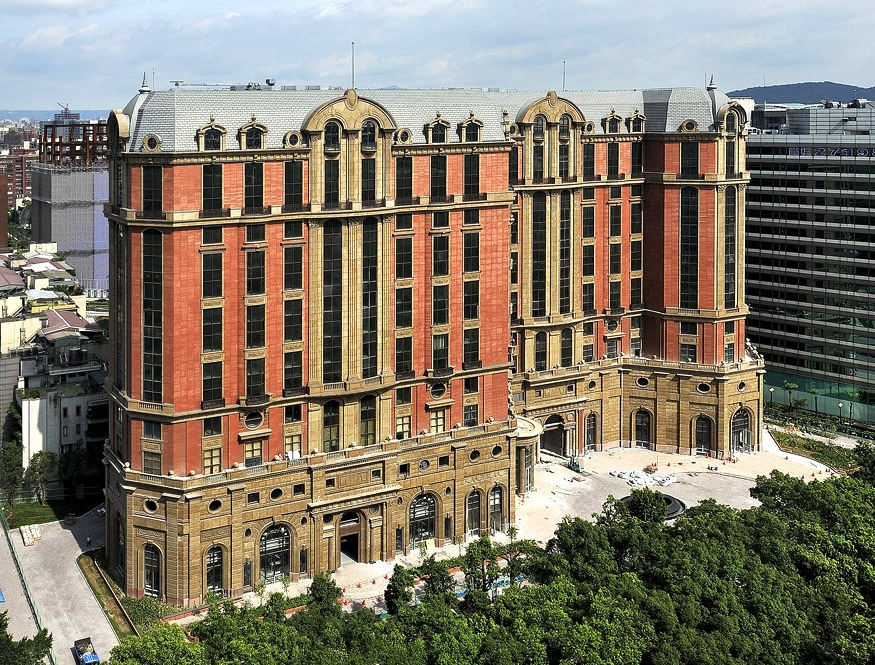Mandarina Crown Hotel,Taipei
Completion
Location
Taipei, Taiwan
Site Area
14,093 m²
Total Floor Area
113,445 m²
Stories
B5 - 14F
Heigh
66 m
Category
Iconic Projects, Hotel
Client
達欣開發
Create the dream of future development
2. Aspirations that the development of the project will become an engine of economic growth and other related industries
4. Creating a win-win scenario for the government, local authorities and Zhongtai hotel corporation
Create a new urban fabric for the region
2. Historic fabric: the project sits between Dun-hua North Road and Qingcheng Street; according to historic city records, Qingcheng Street has historical significance while Dun-hua Rd. acts as a central thoroughfare. Using the project as a catalyst to link the dual activates and histories of the two streets thus combining the horizontal spatial axis with the vertical axis of time to create a new time-space structure.
Create a humanistic, new urban space
The project consists of three separate parts: Zone Jin One, Zone Jin Two and an urban park given to the local residents as compensation. Zone Jin One will contain an international tourist hotel, a shopping center, restaurants and a financial services center; Zone Jin Two is to be urban residential while the neighborhood park will house a neighborhood activities center. The project functions in reality as a miniature urban residential zone, combining residential, leisure and shopping into a residential complex. To create a new humanistic urban environment, the project has linked the three areas together through pedestrian walkways. First, along Dun-hua North Road an open plaza, combined with gateway made between the various building massings, creates an entrance space and place for leisure activities. Along Qingcheng Street, landscape elements were designed in such a way as to limit vehicular traffic and thus guaranteeing the free movement of people and cars. Furthermore, the passageways to the area become progressively smaller thus creating an internal, Paradise-like tranquil space cut off from the hustle and bustle of Dun-hua North Road.
Creating urban lungs
Dun-hua Road sits within Taipei’s “Dong Qu (East District)” commercial center and is lined on either side by modern office towers. These buildings are usually highly enclosed and cuts off the spatial continuity between the green walkways located in the middle of these streets with the pocket parks in the back alleys of these residential neighborhoods. The project located on Jin One and Jin Two utilizes the passage space created between the two structures to link the green spaces between Dun-hua Rd and the pocket parks and also creates a micro-climate that increases the air flow within the buildings. Along the path of the airflow, greenery and water features were placed to enrich the quality of the air passing through. Coupled with the pedestrian pathway, this creates a high quality, free-breathing district with the commercial zone of Dun-hua Rd.
2. Aspirations that the development of the project will become an engine of economic growth and other related industries
4. Creating a win-win scenario for the government, local authorities and Zhongtai hotel corporation
Create a new urban fabric for the region
2. Historic fabric: the project sits between Dun-hua North Road and Qingcheng Street; according to historic city records, Qingcheng Street has historical significance while Dun-hua Rd. acts as a central thoroughfare. Using the project as a catalyst to link the dual activates and histories of the two streets thus combining the horizontal spatial axis with the vertical axis of time to create a new time-space structure.
Create a humanistic, new urban space
The project consists of three separate parts: Zone Jin One, Zone Jin Two and an urban park given to the local residents as compensation. Zone Jin One will contain an international tourist hotel, a shopping center, restaurants and a financial services center; Zone Jin Two is to be urban residential while the neighborhood park will house a neighborhood activities center. The project functions in reality as a miniature urban residential zone, combining residential, leisure and shopping into a residential complex. To create a new humanistic urban environment, the project has linked the three areas together through pedestrian walkways. First, along Dun-hua North Road an open plaza, combined with gateway made between the various building massings, creates an entrance space and place for leisure activities. Along Qingcheng Street, landscape elements were designed in such a way as to limit vehicular traffic and thus guaranteeing the free movement of people and cars. Furthermore, the passageways to the area become progressively smaller thus creating an internal, Paradise-like tranquil space cut off from the hustle and bustle of Dun-hua North Road.
Creating urban lungs
Dun-hua Road sits within Taipei’s “Dong Qu (East District)” commercial center and is lined on either side by modern office towers. These buildings are usually highly enclosed and cuts off the spatial continuity between the green walkways located in the middle of these streets with the pocket parks in the back alleys of these residential neighborhoods. The project located on Jin One and Jin Two utilizes the passage space created between the two structures to link the green spaces between Dun-hua Rd and the pocket parks and also creates a micro-climate that increases the air flow within the buildings. Along the path of the airflow, greenery and water features were placed to enrich the quality of the air passing through. Coupled with the pedestrian pathway, this creates a high quality, free-breathing district with the commercial zone of Dun-hua Rd.




